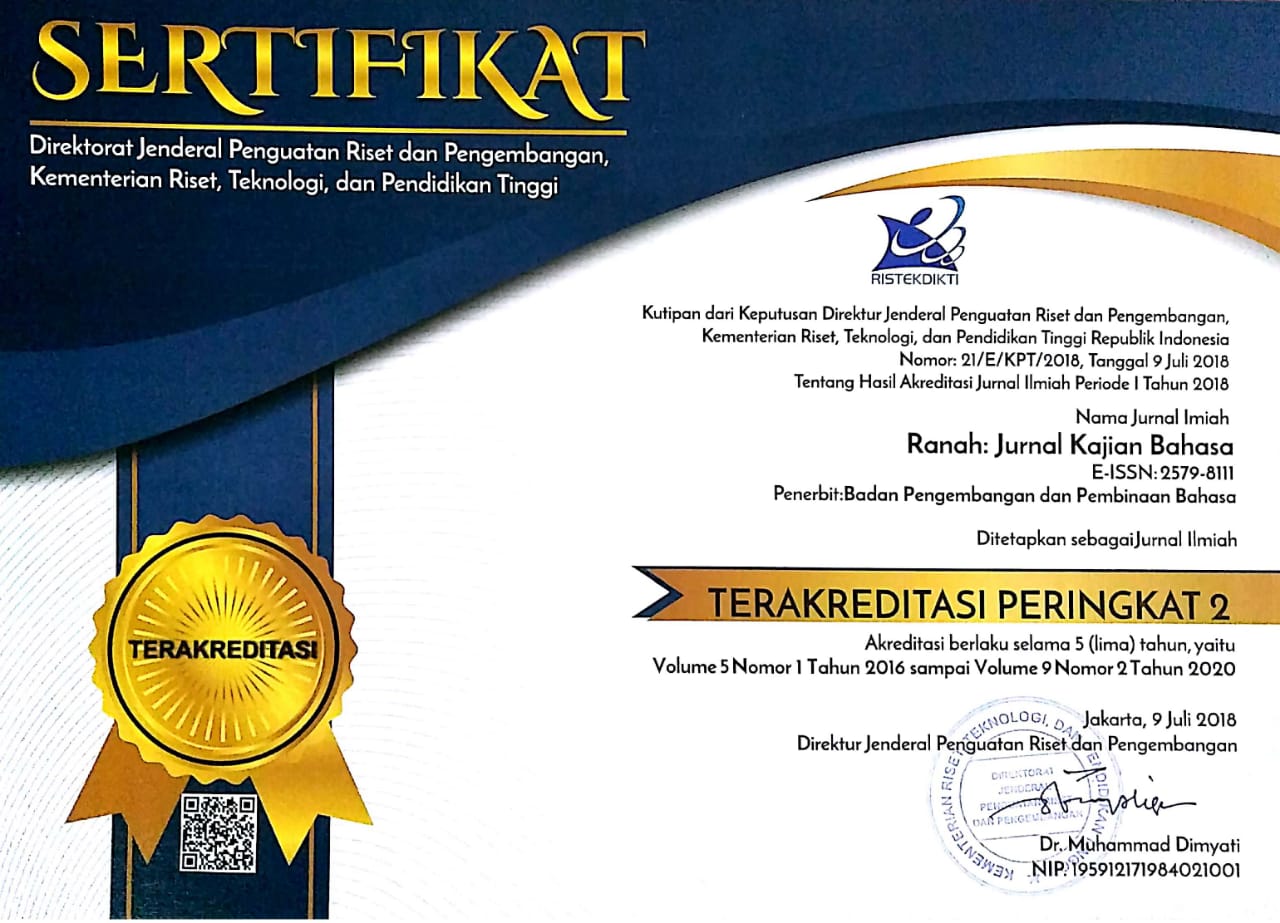Verb Structure and Grammatical Encoding in the Spontaneous Speech of Indonesian Speakers with Broca’s Aphasia
Abstract
This study aimed to obtain the characteristics of verb structure in the speech of Indonesian speakers with Broca’s aphasia and their relation to the Argument Structure Complexity Hypothesis (ASCH) and grammatical encoding. There are three questions, namely the interrelationships of verbs and syntactic functions, interrelationship of verbs and semantic functions, and the contribution to the ASCH and grammatical coding. Eight participants took part, divided into four with aphasia and four Non-Brain Damaged (NBD) participants as controls. The research used an experimental research method. The instruments were five images adapting Cookie Theft (an instrument used in an aphasia test in various languages) and 3 instructions to tell about daily activities. The results showed that participants with aphasia tended to use verbs in simpler structures than controls. Therefore, this study supports the ASCH about the argument simplification and tendency of grammatical coding problems, important as coming from Indonesian, an Austronesian language. Clinical implications are discussed.
Abstrak
Penelitian ini bertujuan untuk mendapatkan karakteristik struktur verba dalam tuturan spontan penutur Bahasa Indonesia dengan afasia Broca dan hubungannya dengan Argument Structure Complexity Hypothesis (ASCH) dan pengkodean gramatikal. Ada tiga pertanyaan penelitian, yaitu keterkaitan verba dan fungsi sintaksis, keterkaitan verba dan fungsi semantik, dan kontribusi terhadap ASCH dan pengkodean gramatikal. Delapan peserta ikut serta, dibagi menjadi empat dengan afasia dan empat peserta tanpa gangguan syaraf (Non-Brain Damaged: NBD) sebagai kontrol. Metode penelitian yang digunakan adalah metode eksperimental. Instrumen yang digunakan adalah lima buah gambar yang mengadaptasi Cookie Theft (instrumen dalam tes afasia lintas bahasa) serta tiga buah instruksi untuk bercerita tentang kegiatan sehari-hari. Hasil penelitian menunjukkan bahwa peserta dengan afasia cenderung menggunakan verba dalam struktur yang lebih sederhana daripada peserta NBD. Oleh karena itu, penelitian ini mendukung ASCH tentang penyederhanaan argumen dan kecenderungan terjadinya masalah pengkodean gramatikal. Dukungan ini penting karena datang dari Bahasa Indonesia yang merupakan bahasa rumpun Austronesia. Implikasi klinis juga disarankan.
Keywords
Full Text:
PDFReferences
Akmajian, Adrian. (1995). Linguistics: An introduction to language and communication. MIT Press.
Alwi, H., Dardjowidjojo, S., Lapoliwa, H., & Moeliono, A. M. (2003). Tata Bahasa Baku Bahasa Indonesia: Edisi Ketiga. Jakarta: Departemen Pendidikan dan Kebudayaan Republik Indonesia.
Anjarningsih, H. Y., & Bastiaanse, R. (2011). Verbs and time reference in Standard Indonesian agrammatic speech. Aphasiology, 25(12). https://doi.org/10.1080/02687038.2011.626844
Anjarningsih, H. Y., Haryadi-Soebadi, R. D., Gofir, A., & Bastiaanse, R. (2012). Characterising agrammatism in Standard Indonesian. Aphasiology, 26(6). https://doi.org/10.1080/02687038.2011.648370
Aribowo, L. (2016). Gangguan produksi bunyi ujaran penderita afasia karena stroke: Studi kasus di dep/SMF penyakit saraf RSUD Dr. Soetomo Surabaya (unpublished doctoral dissertation). Universtas Gajah Mada.
Arslan, S., Bamyacı, E., & Bastiaanse, R. (2016). A characterization of verb use in Turkish agrammatic narrative speech. Clinical Linguistics and Phonetics, 30(6). https://doi.org/10.3109/02699206.2016.1144224
Bastiaanse, R., & Van Zonneveld, R. (2004). Broca's aphasia, verbs and the mental lexicon. Brain and Language, 90(1-3). https://doi.org/10.1016/S0093-934X(03)00432-2
Biran, M., & Fisher, S. (2015). Structured treatment can improve predicate argument structure impairment. Aphasiology, 29(1). https://doi.org/10.1080/02687038.2014.961122
Bos, L. S., & Bastiaanse, R. (2014). Time reference decoupled from tense in agrammatic and fluent aphasia. Aphasiology, 28(5). https://doi.org/10.1080/02687038.2014.886322
Casilio, M., Rising, K., Beeson, P. M., Bunton, K., & Wilson, S. M. (2019). Auditory-perceptual rating of connected speech in Aphasia. American Journal of Speech-Language Pathology, 28(2). https://doi.org/10.1044/2018_AJSLP-18-0192
Centeno, J. G., & Obier, L. K. (2001). Agrammatic verb errors in Spanish speakers and their normal discourse correlates'. Journal of Neurolinguistics, 14(2-4). https://doi.org/10.1016/S0911-6044(01)00023-9
https://doi.org/10.1016/S0911-6044(01)00023-9
Dharmaperwira-Prins, R. (1996). TADIR: Tes afasia untuk diagosis, informasi, rehabilitasi. Penerbit Fakultas Kedokteran Universitas Indonesia.
Dragoy, O., & Bastiaanse, R. (2010). Verb production and word order in Russian agrammatic speakers. Aphasiology, 24(1). https://doi.org/10.1080/02687030802586902
Goodglass, H., & Kaplan, E. (1972). Boston diagnostic examination for aphasia. Philadelphia: Lea and Febiger.
Halim, A. (1969). Intonasi dalam hubungannya dengan sintaksis bahasa Indonesia. Djambatan.
Heinzova, P., Carreiras, M., & Mancini, S. (2023). Processing argument structure complexity in Basque-Spanish bilinguals. Language, Cognition and Neuroscience, 38(5). https://doi.org/10.1080/23273798.2022.2154370
Henry, M. L., Hubbard, H. I., Grasso, S. M., Mandelli, M. L., Wilson, S. M., Sathishkumar, M. T., Fridriksson, J., Daigle, W., Boxer, A. L., Miller, B. L., & Gorno-Tempini, M. L. (2018). Retraining speech production and fluency in non-fluent/agrammatic primary progressive aphasia. Brain, 141(6). https://doi.org/10.1093/brain/awy101
Jap, B. A., Martinez-Ferreiro, S., & Bastiaanse, R. (2016). The effect of syntactic frequency on sentence comprehension in standard Indonesian Broca's aphasia. Aphasiology, 30(11). https://doi.org/10.1080/02687038.2016.1148902
Kolk, H. H. J., & Van Grunsven, M. M. F. (1985). Agrammatism as a variable phenomenon. Cognitive Neuropsychology, 2(4). https://doi.org/10.1080/02643298508252666
Kolk, H., & Heeschen, C. (1990). Adaptation symptoms and impairment symptoms in Broca's aphasia. Aphasiology, 4(3), 221-231. https://doi.org/10.1080/02687039008249075
Kridalaksana, Harimukti. (2002). Struktur, kategori, dan fungsi dalam teori sintaksis. Universitas Katolik Atma Jaya.
Kuvač Kraljević, J., Matić Škorić, A., & Lice, K. (2023). Main Concepts in the Spoken Discourse of Persons with Aphasia: Analysis on a Propositional and Linguistic Level. Languages, 8(2). https://doi.org/10.3390/languages8020120
Levelt, W. J. M. (1989). Speaking: From intention to articulation. The MIT Press.
Malyutina, S., Richardson, J. D., & Den Ouden, D. B. (2016). Verb Argument Structure in Narrative Speech: Mining AphasiaBank. Seminars in Speech and Language, 37(1). https://doi.org/10.1055/s-0036-1572383
Maul, K. K., Conner, P. S., Kempler, D., Radvanski, C., & Goral, M. (2014). Using informative verbal exchanges to promote verb retrieval in nonfluent aphasia. American Journal of Speech-Language Pathology, 23(3). https://doi.org/10.1044/2014_AJSLP-13-0004
https://doi.org/10.1044/2014_AJSLP-13-0004
Miceli, G., Mazzucchi, A., Menn, L., & Goodglass, H. (1983). Contrasting cases of Italian agrammatic aphasia without comprehension disorder. Brain and Language, 19(1). https://doi.org/10.1016/0093-934X(83)90056-1
Poirier, S. È., Fossard, M., & Monetta, L. (2023). The efficacy of treatments for sentence production deficits in aphasia: a systematic review. Aphasiology, 37(1). https://doi.org/10.1080/02687038.2021.1983152
Postman, W. A. (2004). Processing of complex sentences in a case of aphasia in Indonesian: Thematic vs. linear strategies. Journal of Neurolinguistics, 17(6). https://doi.org/10.1016/j.jneuroling.2004.09.001
Rossi, E., & Bastiaanse, R. (2008). Spontaneous speech in Italian agrammatic aphasia: A focus on verb production. Aphasiology, 22(4). https://doi.org/10.1080/02687030701407093
Silagi, M. L., Ferreira, O. P., de Almeida, I. J., Simões, J. de S., Zampieri, S. A., de Santana, B. R. F., & Mansur, L. L. (2020). Treatment of agrammatism in oral and written production in patients with Broca's aphasia: The use of implicit and explicit learning. Dementia e Neuropsychologia, 14(2). https://doi.org/10.1590/1980-57642020dn14-020002
Sneddon, J. N., A., D., & Ewing, M. C. (2010). Indonesian reference grammar (2nd edition).
Sugiyono. (2015). Struktur Melodik Bahasa Indonesia. Kajian Linguistik dan Sastra, 19(1). https://doi.org/10.23917/kls.v19i1.4403
Suhardiyanto, T. (2003). Agramatisme pada afasia: kajian singkat terhadap empat penderita afasia Broca. Linguistik Indonesia, 21, 309-320.
Sung, J. E. (2016). The Effects of Verb Argument Complexity on Verb Production in Persons with Aphasia: Evidence from a Subject-Object-Verb Language. Journal of Psycholinguistic Research, 45(2). https://doi.org/10.1007/s10936-014-9346-y
Thompson, C. K. (2003). Unaccusative verb production in agrammatic aphasia: The argument structure complexity hypothesis. Journal of Neurolinguistics, 16(2-3). https://doi.org/10.1016/S0911-6044(02)00014-3
Thompson, C. K., Riley, E. A., den Ouden, D. B., Meltzer-Asscher, A., & Lukic, S. (2013). Training verb argument structure production in agrammatic aphasia: Behavioral and neural recovery patterns. Cortex, 49(9). https://doi.org/10.1016/j.cortex.2013.02.003
DOI: https://doi.org/10.26499/rnh.v12i2.4749
Refbacks
- There are currently no refbacks.








